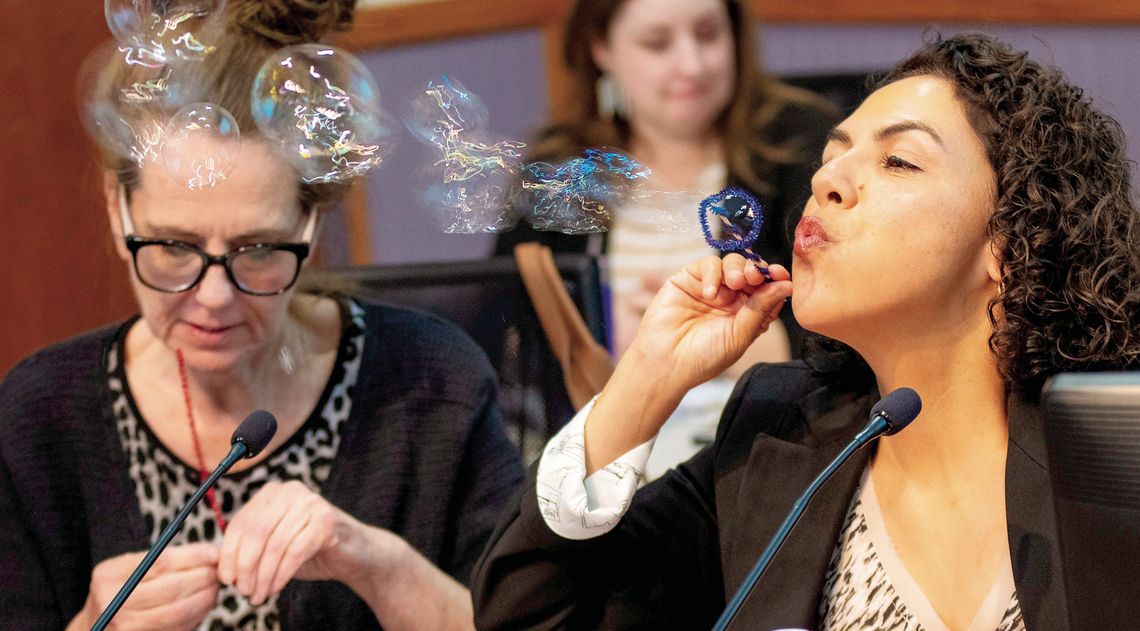Grounding science lessons in phenomena
Elgin campuses are matching State Board of Education requirements with an update to instructional materials, technology applications and how students will be interacting with science programs.
Elgin Independent School District Director of Curriculum Nicole Hohensee provided an overview of the newly adopted education standard in a recent School Board meeting, along with a bubble-blowing demonstration of what science teachers will soon be practicing.
“The big change is the how,” said Hohensee. “The content necessarily hasn’t changed that much, but what we are seeing are some significant content shifts, moving from grade level to grade level.”
In 2021, the state adopted the Texas Essential Knowledge and Skills standard, determining what teachers are required to communicate each year. This year, Elgin ISD is making changes to its K-12 science curriculum, K-eight technology applications and various Career and Technical Education courses to meet the new TEKS requirements.
A district committee looked through publishers putting out new material, reviewed the changes to TEKS and decided that Savvas Learning Company was the best option for Elgin ISD learners. The selection is a user-friendly resource aligned to TEKS and district policies that will completely revamp the district’s science curriculum and the way it is taught.
“We can differentiate this learning with all levels of kids,” added Hohensee.
The program focuses on 3D learning and the anchoring of content in phenomena.
“This is just things that are happening around us in the real world all the time. What we’re going to do is anchor all of our science instruction into this real world application, and we’re going to do it in a way where kids are noticing and wondering about the world around them,” the director said.
To demonstrate this, Hohensee walked the board through what one of the lessons might look like by blowing some bubbles. She asked the council if bubbles always come out round and had them proceed with scientific reasoning.
Board members made a claim, created a plan, tested the claim, gathered evidence and explained reasoning by crafting uniquely shaped wands. After conclusions were drawn, Hohensee described how explanations and lessons from this can change based on grade level. Younger pupils will conclude that bubble solution is sticky and has to hold air, while higher grades will delve into surface tension and how particles need to attach evenly.
“This one experiment can be done at all levels of school…in order to teach this way, we have to have really good instructional material,” Hohensee said.
This integration of both science and engineering practices is pivotal in the program, along with recurring themes and concepts like cause/effect relationships, the flow of energy and the relationship between structure and function. This provides a framework for students to make connections between different areas of science, according to Hohensee.
The lessons include recommendations and experiences to support all levels of learning and students with different backgrounds and abilities, but “teaching this way requires materials,” Hohensee added. Savvas will provide everything needed for hands-on lessons, and a budget is expected to be brought forward later this month.
Additionally, K-eight technology applications will be seeing attention with Ellipses Education, a publisher approved by the state board that covers 100% of TEKS and meets all criteria areas, according to Hohensee. With this, the district will be providing grade-specific TEKS instead of the current grouped-grade system.
The director is also looking at adding a supplemental typing program with the change of curriculum, aiming to make pupils feel confident in their skills when it comes time to type for the State of Texas Assessments of Academic Readiness.
.png)






